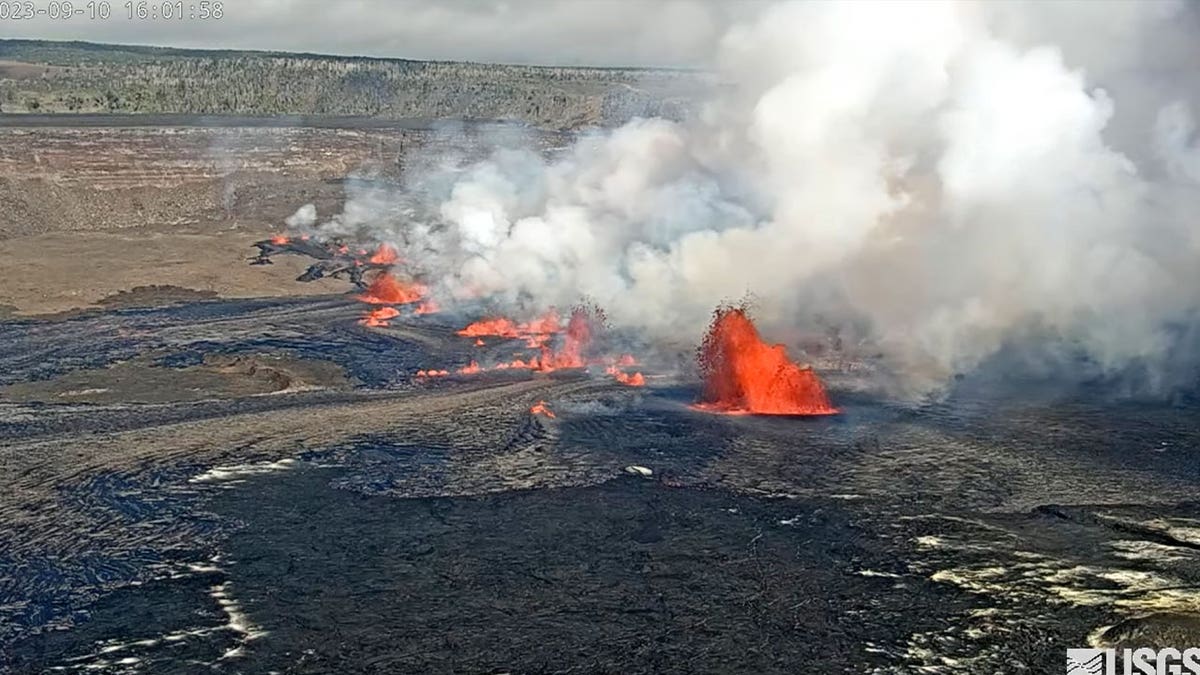Kilauea Volcano: 40-Year-Old Eruption Pattern Returns

Table of Contents
The 1983-2018 Eruptive Cycle and Its Resemblance to Current Activity
The Kilauea volcano experienced a significant eruptive cycle from 1983 to 2018, characterized by persistent activity at Puʻu ʻŌʻō crater. This period saw frequent lava flows, significant ground deformation, and substantial changes in the volcano's landscape. The current activity shows striking similarities to this past cycle, prompting concern among volcanologists.
-
Comparison of lava flow rates and volumes: Preliminary data suggests a comparable rate of lava effusion to the earlier period, though further analysis is needed for definitive comparison of total volumes. Scientists are closely monitoring the flow rates and paths to predict potential impacts on infrastructure and populated areas.
-
Analysis of seismic activity and ground deformation data: The current increase in seismic activity and ground deformation mirrors patterns observed in the lead-up to significant eruptive events during the 1983-2018 cycle. This data provides crucial insights into the magma movement beneath the surface and helps scientists assess the potential for future eruptions.
-
Role of Puʻu ʻŌʻō crater: Puʻu ʻŌʻō crater played a central role in the 1983-2018 eruptions, acting as a primary vent for lava. While the current activity isn't solely focused on Puʻu ʻŌʻō, similar volcanic features are showing increased activity, suggesting a parallel pattern in magma movement. The long-term changes to the landscape and subsurface plumbing system caused by the previous cycle may be influencing the current eruption. Understanding the interconnectedness of these features is key to forecasting future activity.
Understanding the Recurring Eruption Pattern and Its Geological Implications
The cyclical nature of Kilauea's eruptions is likely driven by complex geological factors influencing the volcano's plumbing system. These factors contribute to the build-up and release of pressure within the magma chamber.
-
Magma chamber dynamics and pressure build-up: The Kilauea magma chamber acts like a vast reservoir, slowly accumulating magma over time. As pressure increases, it eventually overcomes the strength of the surrounding rocks, leading to eruptions. The current pattern suggests a regular replenishment of the magma chamber, contributing to the cyclical nature of activity.
-
Role of tectonic plates and volcanic plumbing systems: Kilauea's location above a hotspot and the movement of tectonic plates influence the pathways and pressure within its complex volcanic plumbing system. This intricate network of conduits and chambers plays a crucial role in determining where and how eruptions occur, creating the observed pattern.
-
Scientific studies supporting the cyclical pattern: Several research papers published in peer-reviewed journals support the theory of cyclical activity at Kilauea. These studies draw on decades of monitoring data, analyzing seismic activity, lava flow patterns, and ground deformation to identify recurring trends indicative of predictable eruption patterns.
Current Monitoring and Hazard Assessment of Kilauea's Activity
The USGS Hawaiian Volcano Observatory (HVO) employs sophisticated monitoring techniques to track Kilauea's activity and assess potential hazards. This continuous monitoring is vital for informing public safety measures.
-
Seismic monitoring and GPS measurements: A network of seismometers constantly measures ground shaking, providing critical data on magma movement. GPS measurements track ground deformation, indicating changes in the shape of the volcano, which often precede eruptions.
-
Gas emission analysis and lava flow mapping: Analysis of volcanic gases provides insights into the magma's composition and the intensity of volcanic activity. Lava flow mapping helps predict the potential paths of lava flows and assess the risk to nearby communities.
-
Hazard assessment and public safety: The USGS issues volcano alert levels (e.g., Watch, Warning, Advisory) based on the assessed risk. These alerts inform emergency management agencies and the public, allowing for timely evacuation and mitigation measures. The consistent monitoring allows for a proactive approach to hazard management, minimizing risk to life and property.
Potential Impacts on Local Communities and Infrastructure
The ongoing Kilauea eruption poses several significant hazards to nearby communities and infrastructure.
-
Potential for lava flows to damage homes and roads: Lava flows can bury homes, destroy infrastructure (roads, bridges, power lines), and disrupt transportation networks. The extent of the damage depends on the volume and path of the lava flows.
-
Risks associated with volcanic gases (vog): Volcanic gases, including sulfur dioxide, can create vog (volcanic smog), which can cause respiratory problems and other health issues. This can affect air quality across a large area, impacting both residents and tourists.
-
Economic impacts and disruption to tourism: The eruption can disrupt tourism, a vital sector of the Hawaiian economy. Evacuations, road closures, and air quality issues can significantly impact businesses and employment.
Conclusion
The return of a 40-year-old eruption pattern at Kilauea volcano is a significant event, highlighting the cyclical nature of its activity and the importance of ongoing monitoring by the USGS Hawaiian Volcano Observatory. The similarities between the past and present cycles underscore the need for preparedness and informed decision-making by local authorities and residents. Understanding the Kilauea eruption patterns is crucial for mitigating risks and ensuring the safety of local communities and visitors. Stay informed about the latest developments concerning Kilauea volcano activity by regularly checking official sources such as the USGS Hawaiian Volcano Observatory. Learn more about Kilauea volcano eruption history and preparedness strategies to better understand and prepare for future volcanic activity.

Featured Posts
-
 Arnold Schwarzenegger Supports Son Patricks Nude Scene
May 06, 2025
Arnold Schwarzenegger Supports Son Patricks Nude Scene
May 06, 2025 -
 Nikes New Fitness Venture With Kim Kardashians Skims
May 06, 2025
Nikes New Fitness Venture With Kim Kardashians Skims
May 06, 2025 -
 Miley Cyrus A Daughters Complex Love For A Narcissist Father
May 06, 2025
Miley Cyrus A Daughters Complex Love For A Narcissist Father
May 06, 2025 -
 Meet Tracee Ellis Rosss Famous Family A Look At Her Lineage
May 06, 2025
Meet Tracee Ellis Rosss Famous Family A Look At Her Lineage
May 06, 2025 -
 Hasil Piala Asia U 20 Iran Hancurkan Yaman 6 0
May 06, 2025
Hasil Piala Asia U 20 Iran Hancurkan Yaman 6 0
May 06, 2025
